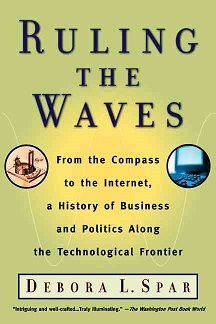Ruling the Waves: A Saecular Breakdown

I’ve posted before about “books from the Third Turning that I didn’t get around to until the Fourth Turning.” Waiting on the bookshelf for some time has been Ruling the Waves, by Debora L. Spar. This book is subtitled “a History of Business and Politics along the Technological Frontier” and in the introduction discusses the Internet a bit. It was published in 2001 (pre-9/11!), when the commercial Internet was young and Web 2.0 was just getting going. The book was hoping, then, to shed some light on what was to come in the development of cyberspace.
The author has a premise that when a ground-breaking new technology is introduced, it goes through four phases of development before becoming a commonplace part of everyday life on which we depend. First there is the invention phase, involving just a few people, and then the entrepreneur phase, where risk-takers develop the new technology commercially. Next is what she calls a period of “creative anarchy,” when the most successful entrepreneurs battle for supremacy in the marketplace, and finally the rulemaking phase, where those who now dominate the technology application push for a fixed legal structure within which to operate.
She goes through different waves of technology, and I was interested to see how what she describes compares to Strauss & Howe saecular theory. The first wave Spar analyzes is the wave of advancements that led to the Age of Discovery – but this happens over a long period of time (centuries) so bringing saecular theory into it seems difficult. The next technological wave was that of the telegraph, and here it is easier to do the analysis.
I was half-expecting to find that the Gilded generation were major players in the drama of the development of the telegraph, since they are the Nomad generation of the Civil War Saeculum. After all, the Nomad generation of the current saeculum, my generation, has had a big part to play in the rise of Internet technology. But what I found is that the the main players in the story (looking at the U.S. part of it) were all from two generations – Compromise and Transcendental. The Gilded are nowhere to be found, probably because they were too young.
The narrative of the development of the telegraph did track pretty well with the turnings of the Civil War Saeculum, however. The invention period occurs at the end of the Transcendental Awakening, the 2nd turning. It involves two key players, Samuel Morse (b. 1791, Compromise Generation) of course, and Alfred Vail (b. 1807, Transcendental Generation), who worked closely with Morse. The idea of transmitting electricity over wires had been known about for decades; their genius was in combining the transmission with encoding, to create information. They managed to get some public backing through Congress to build a line, but the enterprise failed.
So then came the entrepreneurs to buy them out, and build a private enterprise instead. A key player was Amos Kendall (b. 1789, Compromise), a former postmaster general who left his position specifically for this purpose. He proved that it was possible to raise funds privately to build a telegraph line, and once the public caught on to what the technology made possible, the money started flowing into more and more companies building regional lines. Other big time entrepreneurs of this period included Henry O’Rielly (b. 1806, Transcendental) and Cyrus Field (b. 1819, Transcendental), who built the first trans-Atlantic line.
Without going into too much detail, the competition became fierce, as well as costly to the companies involved. In the period leading up to the Civil War, that is the 3rd turning in saecular terms, there was fighting over patent rights and access to markets, as well as confusion sowed by competing signal standards and encoding methods. This is the “creative anarchy” period in Spar’s terminology.
The winner of this period of conflict turned out to be Western Union, thanks in large part to the efforts of Hiram Sibley (b. 1807, Transcendental), who led it in its transformation into a telegraph company, eventually establishing the first transcontinental line. With this consolidation came standardization – the rulemaking period. After the Civil War, in the 1st turning of the next saeculum, Western Union became a huge and powerful monopoly, enough to worry people into pressuring the government to regulate it, though not much was done in the Gilded Age.
I just find it fascinating that so many of the key players in the development of the telegraph were from the Transcendental generation, the Prophet archetype of the Civil War Saeculum. They were the Bill Gates and Steve Jobs equivalents of their time, and of this technological wave.
It wasn’t until the end of the new saeculum, with the founding of the FCC, that private communication networks became thoroughly regulated. That was during the era of radio, which is actually the next technology covered by Spar’s book. So I will continue reading Ruling the Waves, and report in another post what I discover.



